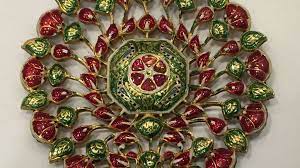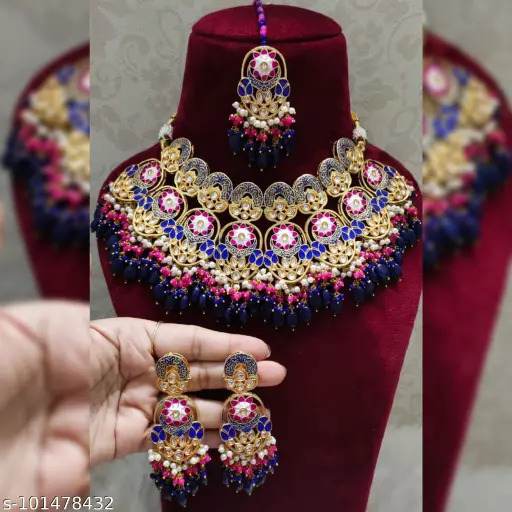Jewelry is not just an accessory; it’s an expression of culture, art, and history. Among the many jewelry-making techniques that you see passing down through generations, Meenakari jewellery stands out as a vibrant testament to skillful artisanship. This traditional Indian craft of enameling metal surfaces, primarily gold and silver, is well famous for its intricate designs and brilliant hues.
Origins and History
Meenakari, the art of enameling metal surfaces, has a storied history that dates back to ancient times. Its origins can be traceable back to Persia, from where the craft spread to India through the Mughal invasion in the 16th century. The Persian enamellists were master artisans who specialized in decorating metal objects with vibrant colors.
When it arrived in India, local craftsmen embraced the technique and infused it with their indigenous artistry, leading to a unique Indo-Persian blend. The Mughal emperors, particularly Akbar, were great patrons of this art form, and under their patronage, Meenakari achieved new heights of sophistication.
Initially, Meenakari was largely used for adorning jewelry and accessories worn by the royalty and the nobles. Over time, it became popular among the general populace. The origin of Rajasthani Jewelry from the city of Jaipur became the hub for Meenakari work in India. It is famous for its distinctive blue and green enameling on gold. Varanasi is also famous for its exquisite Meenakari craftsmanship.
The process of creating Meenakari jewelry involves engraving the design on the metal followed by filling the grooves with colored enamel. The piece is then fired at a high temperature, which fuses the enamel to the surface. The result is a glossy, durable finish that showcases intricate designs and patterns. Meenakari remains a treasured art form, revered for its beauty, vibrant colors, and intricate craftsmanship.
The Craftsmanship of Meenakari Jewellery
Meenakari jewellery epitomizes the zenith of artistic expression in ornamental design, a craft passed down through generations, deeply rooted in the cultural heritage of India. This intricate art form involves the delicate process of enameling metal surfaces, typically gold and silver, with vibrant and finely powdered glass. Originating in Persia, Meenakari was popularized in India by the Mughal emperors who appreciated its aesthetic appeal and detailed workmanship.
The process begins with the creation of grooves or cells on the metal surface by skilled artisans. These grooves are then meticulously filled with colored enamels. Once the design is laid out and the enamels are applied, the piece is fired at high temperatures. This melting fuses the enamel to the metal, producing a glossy, durable finish. The result is a dazzling array of jewel tones that enhance the metal’s luster.
The motifs in Meenakari gets inspiration from nature, featuring flowers, birds, and foliage, reflecting the subcontinent’s rich flora and fauna. The play of colors is not just visually stunning but also symbolically significant, with each hue representing different aspects of culture and tradition.
The Process: A Symphony of Steps
The Meenakari process can be broken down into several steps:
1. Designing
An intricate pattern is etched onto a metal surface by skilled artisans.
2. Engraving
Grooves are carefully carved to accommodate the enamel.
3. Enameling
Colored enamel is painstakingly applied within the grooves.
4. Firing
The piece is fired in a kiln, allowing the enamel to melt and adhere to the surface.
5. Polishing
After cooling, the piece is polished to reveal its gleaming finish.
6. Stone Setting
If required, precious stones are set to enhance the piece’s beauty.
Regional Variations
Meenakari work varies across different regions of India, each adding its unique touch to the craft. Notable centers include:
- Jaipur: Known for its vibrant use of colors and elaborate designs.
- Varanasi: Specializes in the fine detailing on gold.
- Rajasthan: Famed for its traditional motifs and use of prominent red and green colors.
- Kundan and Meena: A combination where Meenakari is combined with Kundan (the art of setting stones in gold).
The Color Palette
The colors used in Meenakari have their own language. Certain colors are considered traditional, such as green, which symbolizes nature; blue, representing the sky; and red, indicating strength and passion. The choice of colors often depends on regional preferences and the type of metal used.
Themes and Motifs
Meenakari jewellery, a traditional Indian art form, is famous for its vibrant colors and intricate designs. It is embodying themes of nature, spirituality, and royalty. Originating from the Persian enameling craft, Indian artisans embraces Meenakari, especially in Rajasthan and Gujarat, who later infusing it with local cultural motifs.
A central theme in Meenakari work is the celebration of the natural world. Floral patterns, including the lotus and rose, are common, symbolizing purity, beauty, and creation. Fauna motifs, such as peacocks and elephants, represent nobility, wisdom, and good fortune. These natural elements are not merely decorative; they carry deep-seated cultural significance and are often used in jewellery meant for auspicious occasions like weddings.
Spirituality is another dominant theme; Meenakari pieces frequently feature deities and symbols from Hindu mythology. The use of these motifs serves both as an expression of devotion and a means to imbue the wearer with the blessings of the divine.
In terms of royalty, Meenakari is getting historical patronization by Mughal emperors and Rajput kings. This led to the incorporation of luxurious elements like gold, precious stones, and elaborate patterns which signifies wealth and status. The vibrant enamels is often juxtaposing against gold or silver, highlighting the opulence associated with royalty.
The motifs in Meenakari not only serve an aesthetic purpose but also convey messages of fertility, eternity, and divine grace, making each piece a bearer of cultural narratives and personal stories.
Contemporary Meenakari Jewellery
Contemporary Meenakari jewellery represents a harmonious blend of ancient artistry with modern aesthetics. Meenakari, the art of enameling metal surfaces with vibrant colors, carries its roots in Persian craftsmanship and later honing in India.
Today’s Meenakari jewelry brings a fresh perspective to this traditional art form, infusing it with minimalist designs, abstract patterns, and a broader color palette that appeals to modern sensibilities.
While traditional Meenakari often featured intricate floral and faunal motifs in bright, primary colors, contemporary pieces may showcase geometric shapes, pastel shades, and a subtle use of enamel that complements rather than dominates the design. Designers are experimenting with different metals beyond the classic gold and silver, such as copper and brass, which are more accessible and offer a new canvas for the vivid Meenakari colors.
The versatility of contemporary Meenakari jewelry makes it suitable for a range of occasions—from everyday wear to special events. It pairs elegantly with both ethnic and western attire. This is allowing wearers to make a statement that is at once timeless and on-trend. Eco-friendly practices continue to gain importance in jewelry making. Some of the artisans are also exploring sustainable materials and ethical production methods. You follow this to craft Meenakari pieces that are not just beautiful but also conscious of their environmental impact.
Care for Meenakari Jewellery
Meenakari jewelry, with its intricate designs and vibrant enamel work, is a true representation of traditional craftsmanship. To keep its luster and ensure its longevity, proper care is essential.
Firstly, store Meenakari pieces separately in soft-lined compartments to avoid scratches. Exposure to chemicals can damage the enamel, so it’s crucial to remove the jewelry when using household cleaners or personal care products. Always wear your Meenakari items after applying makeup and perfume to prevent any chemical reaction with the enamel.
Always use a soft, dry cloth to do Cleaning. If a deeper clean is necessary, use a damp cloth with mild soap, but avoid soaking the jewelry as water can weaken the enamel over time. It’s advisable to pat the jewelry dry immediately after cleaning.
Avoid dropping Meenakari jewelry as the impact can chip the enamel. Regular checks for loose settings or enamel damage can help in early detection and repair, preserving the beauty of the piece.
Finally, exposure to extreme temperatures or sunlight can cause fading. Store your Meenakari treasures in a cool, dark place when not in use. By following these care guidelines, your Meenakari jewelry will maintain its allure for years to come.
Conclusion
Meenakari jewelry is not merely an adornment but a wearable piece of art that carries centuries of tradition. It carries its vibrant colors, intricate designs, and deep cultural roots. This jewellery design continues to enchant modern wearers just as it did in royal courts centuries ago. Are you a collector, a fashion enthusiast, or someone who appreciates fine craftsmanship?. Meenakari is a style that transcends time, adding elegance and allure to any ensemble.
In embracing Meenakari jewellery, one embraces a slice of history, an art form that carries meticulous preservation and passing down through generations. It stands as a shining example of India’s rich artistic heritage. This remains an integral part of the country’s cultural fabric. Meenakari jewellery does not just accessorize; it tells a story—one of beauty, precision, and timeless appeal.






